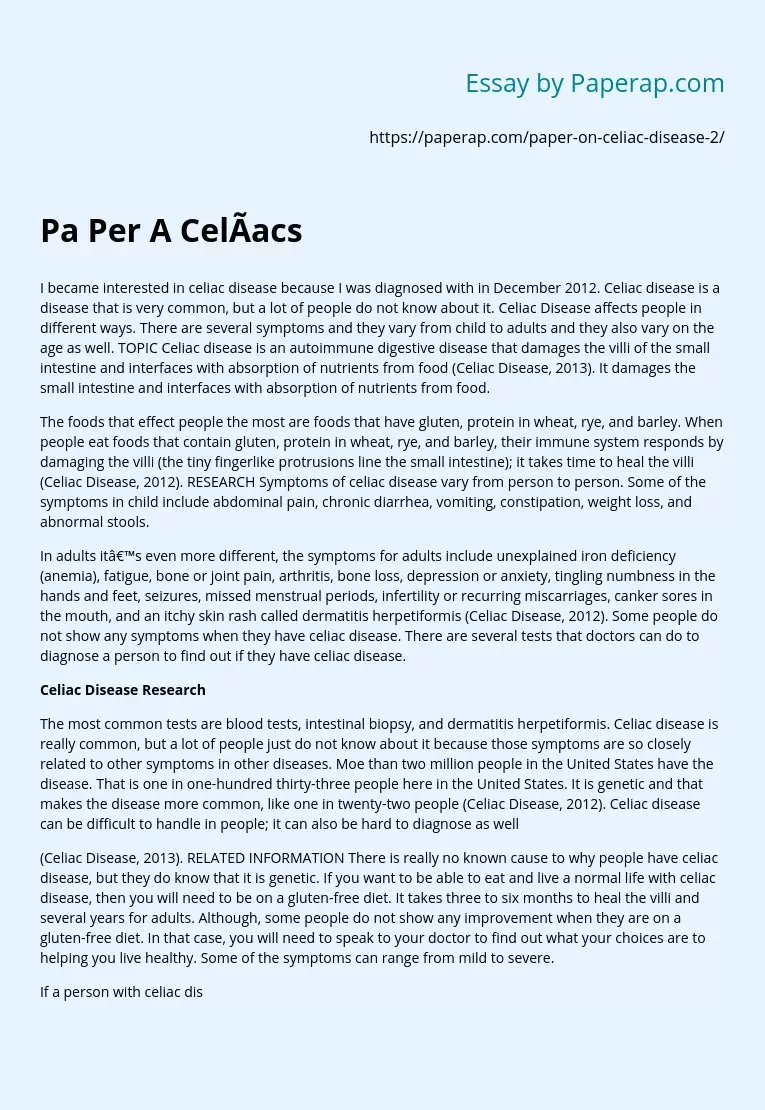Pa Per A Celíacs
The following sample essay on Pa Per A Celíacs I became interested in celiac disease because I was diagnosed with in December 2012. Celiac disease is a disease that is very common, but a lot of people do not know about it. Celiac Disease affects people in different ways. There are several symptoms and they vary from child to adults and they also vary on the age as well. TOPIC Celiac disease is an autoimmune digestive disease that damages the villi of the small intestine and interfaces with absorption of nutrients from food (Celiac Disease, 2013).
It damages the small intestine and interfaces with absorption of nutrients from food.
The foods that effect people the most are foods that have gluten, protein in wheat, rye, and barley. When people eat foods that contain gluten, protein in wheat, rye, and barley, their immune system responds by damaging the villi (the tiny fingerlike protrusions line the small intestine); it takes time to heal the villi (Celiac Disease, 2012).
Symptoms of celiac disease vary from person to person. Some of the symptoms in child include abdominal pain, chronic diarrhea, vomiting, constipation, weight loss, and abnormal stools.
In adults it’s even more different, the symptoms for adults include unexplained iron deficiency (anemia), fatigue, bone or joint pain, arthritis, bone loss, depression or anxiety, tingling numbness in the hands and feet, seizures, missed menstrual periods, infertility or recurring miscarriages, canker sores in the mouth, and an itchy skin rash called dermatitis herpetiformis (Celiac Disease, 2012). Some people do not show any symptoms when they have celiac disease.
There are several tests that doctors can do to diagnose a person to find out if they have celiac disease.
The most common tests are blood tests, intestinal biopsy, and dermatitis herpetiformis. Celiac disease is really common, but a lot of people just do not know about it because those symptoms are so closely related to other symptoms in other diseases. Moe than two million people in the United States have the disease. That is one in one-hundred thirty-three people here in the United States. It is genetic and that makes the disease more common, like one in twenty-two people (Celiac Disease, 2012). Celiac disease can be difficult to handle in people; it can also be hard to diagnose as well
(Celiac Disease, 2013). There is really no known cause to why people have celiac disease, but they do know that it is genetic. If you want to be able to eat and live a normal life with celiac disease, then you will need to be on a gluten-free diet. It takes three to six months to heal the villi and several years for adults. Although, some people do not show any improvement when they are on a gluten-free diet. In that case, you will need to speak to your doctor to find out what your choices are to helping you live healthy. Some of the symptoms can range from mild to severe.
If a person with celiac disease continues to eat gluten, studies have shown that he or she will increase their chances of gastrointestinal cancer by a factor of 40 to 100 times that of the normal population. Further, gastrointestinal carcinoma of lymphoma develops in up to 15 percent of patients with untreated or refractory celiac disease (What is Celiac Disease). People who develop celiac disease are more likely to have an autoimmune disorder, Addison’s disease, Down syndrome, intestinal cancer, intestinal lymphoma, lactose intolerance, thyroid disease, or type 1 diabetes.
A lot of people have a family member with celiac disease and they are at a greater risk for developing the disease. Many adults will have the disease for decades before they actually know they have it. The longer a person goes with being undiagnosed or untreated, the greater chance they have developing long-term complications. Celiac disease affects most people of European (especially Northern European), but studies have said that it can affect any people of any race or culture. Celiac disease cannot be cured; you just have to do what your doctor advises you to do.
A lot of food and medication labels have hidden sources of these grains and ingredients related to them, so you will need to look at ingredients very carefully (Celiac Disease, 2010). There can be damages to your teeth and shorter than expected height. Since there is no non cause to celiac disease, there is no way to prevent the development of the disease. Being aware of the risk factors, can help you out a lot, such as knowing if any family member has the disease. It may help you increase your chances of early diagnosis, treatment, and a long and healthy life.
Pa Per A Celíacs. (2019, Dec 05). Retrieved from https://paperap.com/paper-on-celiac-disease-2/

